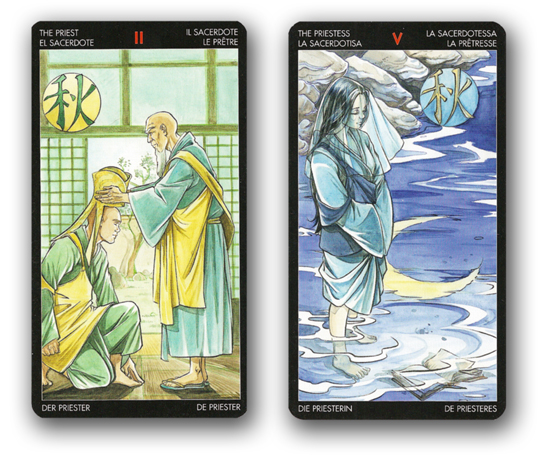The Manga Tarot’s Hierophant

I included this deck just to try and make your brains explode. This is another compelling deck designed by my friend Riccardo Minetti. In this deck he plays with the idea of gender and how it influences our understanding of the cards.
In the Manga Tarot, all the cards that are traditionally male are depicted as female and vice versa. Arcana V becomes The Priestess, and looks very much like a traditional High Priestess card. Arcana II becomes The Priest. For ease of discussion, I’ve pictured them together here.
Many of us blend associations of the card’s number in with the name, image, symbolism, and other associations together to create a card’s meaning.
When a deck renames or renumbers cars, do you incorporate the alterations into your interpretations or stick with what you usually use?
How does renumbering The Hierophant from V to II affect its meaning? With traditional decks we speak of I, The Magician as being the active masculine principal or the anima and II, The High Priestess as the receptive feminine principal or the anima. Can Arcana II be portrayed by a male figure? Conversely, can tradition or teaching (Arcana V) ever be receptive and passive?








To be honest with you, this is where I become very close minded. I don’t like the switching around. I prefer consistency. Therefore, I won’t use a deck like this. (Am I becoming an old tarot stick in the mud? LOL)
First, I just want to say that your card overview entries have been fantastic so far–a great idea and I look forward to future posts in the series! One of the great features of the series is the spotlighting of various decks. The Manga Tarot, from concept to visualization, looks spectacular.
As for the renumbering, it doesn’t seem to affect the meanings of the cards’ images to an unconventional degree. The Priestess as Arcana V still has the images of water (the unconscious), and the sunken text and reflected moon (mystery traditions)–that are among the traditional meanings of The High Priestess as Arcana II. Similarly, The Priest as Arcana II reflects traditional Hierophant/Arcana V elements with its outward elements of spirituality (sun, public ceremony and religious garb).
I would, however, take the alterations into account in laying out the “Hero’s Journey” of the Major Arcana, with the steps of the journey being encountered in a re-imagined way by the Manga Tarot’s creators–but those aspects are something I use more in Tarot meditation rather than in general readings.
I like that he changed gender roles in his version of the deck. I feel it’s good to shake things up with Tarot and go in new directions.
If you know your Tarot..this switch shouldn’t be a problem when doing readings.
Hi Barb,
Ok you’ve made a sail, I’ll definately be buying this one in the next few days. As a person who draws for a hobby, this is just too magnificent to turn down. I love the presision of the work.
I love the Priestess here, obviously deep in meditation, her feet in the stream, connected physically to the element of water. The book under water, almost a reference to the Akashic Record(s) (no?). The Beauty and Quite of the moment.
While the Priest (II) is really playing the Hierophant here, we see the young Priest in this moment of Formal Accomplishment, where in the Old Priest is either Welcoming him into the Caste, or perhaps, passing on his responsibilities to the young one; notice we is not wearing a headress.
Barbara: How does renumbering The Hierophant from V to II affect its meaning?
In this I’m a little uncomfortable, because it really divorces the deck from the tradition of Numerology IMHO; I tend to think of this in terms of a miny fools Journey. 1 Self, 2 Finds a Partner, 3 Celebrates that Discovery. 4 Makes a Home. 5 Has a Child (First Crisis) 6 emerges from the Crisis. 7 Rebellion (Journeyman/ Child now Teen) 8 Mastery. 9 Transcendance. 10 Rebirth. So that Mentor/Student Relationship should be ruled by the 5 IMHO. Im not going to make a big fuss of this, although I used Numerology more when I was new to reading, my readings focus more and more on the art as I progress, and the art is Magnificent.
With traditional decks we speak of I, The Magician as being the active masculine principal or the anima and II, The High Priestess as the receptive feminine principal or the anima. Can Arcana II be portrayed by a male figure?
I like to think so, but then the Magus should be Female. I believe in the Brit-Trads Priest must train Priestess, and Priestess Train Priest; so this would reflect that particular dance no?
Conversely, can tradition or teaching (Arcana V) ever be receptive and passive?
One should hope, when we stop learning from our students, we have become Dogmatic (and I am about somethings you know) and what ever Tradition we represtent has begun dying on the vine, (no?) Tradition is important, I have always been attracted to the Older forms of what ever, Karate, Religion, Art – but Tradition needs to responds to the Present while honoring the past, a tradition cannot survive if it ignores the present chanting; “This is how things have always been done.” We dont live in the Always, we live in the now after all.
Thanks again for introducing me to a wonderful deck. Blessings, BB.
Hello BB! I imagine people visit this blog to read your comments more than anything else. They are always thought provoking and intelligent. Thank you for sharing so much.
I’m so glad you like the art of the Manga Tarot; it is one of my favorites as far as art goes.
But I am such a traditionalist. The switching numbers, etc. freaks me out. Which I tell myself is good for me. So I do work with other decks, just so I don’t, as you say, “begin dying on the vine.” That would be easy to do, if I let it happen.
Once, when I wrote about the Tarot of Elves, I wondered if there is a difference between a reading deck and a study deck. The consensus seemed to be that all decks are by definition reading decks. But I’m not sure. For me, so seem more like study decks, to expand my thoughts and keep me fresh. There are many decks I hang out with but I don’t necessarily read with them.
For my money, it doesn’t matter if you change the ordering of the cards, or if you portray a traditionally male (active) card as female (passive).
The fact that it can matter shows how conditioned we are to viewing the cards in a certain way. I’ve always felt that to read a “traditional tarot deck” involved a process of brain washing or conditioning. It’s not real, no more so than an alternative (like the Manga Tarot).
I remember reading a lot about the Kabbalah when I was younger. I remember thinking that to truly see every component of the world as belonging to the Tree of Life, I would have to spend a long time conditioning my mind to respond to reality as if the “Tree was real” – which it’s not. It would feel real, but that’s the beauty of it. An individual can freely choose to condition their mind, and if they do it correctly, their mind will respond as if its real. Job done!
Most of the gender distinction that is present within current culture has thousands of years of history to it. The most obvious stuff started around 2000 years ago.
… ummm … I’m babbling now! Better stop.
I guess my views on all that stuff is that “truth” is never true!
Just recieved my copy of this beautifal deck today, TY for introducing me to these cards. The art is Magnificent, Im very happy with this one, and Im pretty hard to please that way. BB.
The Journey of the Hero is usually seen as a “line”, and sometimes as a “circle”.
This is not necessarely true, however. We live in a complicated world, and we often progress/evolve in different – unlinear – ways.
I am a bit biased on the Manga (I designed it, after all: hi Barbara!). And sometimes, when you create a deck, it is not because you know the answer, but because you are asking the question.
Practically, however, if you see the Hierophant and the High Priestess as complimentary to each other, they should be on the same level. For instance, is shared/lived Faith (Yang-Hierophant) more important than inner/experienced Faith (Yin-High Priestess)?
Or the other way round.
If You give a number to them, in a way, you are taking sides.
ric